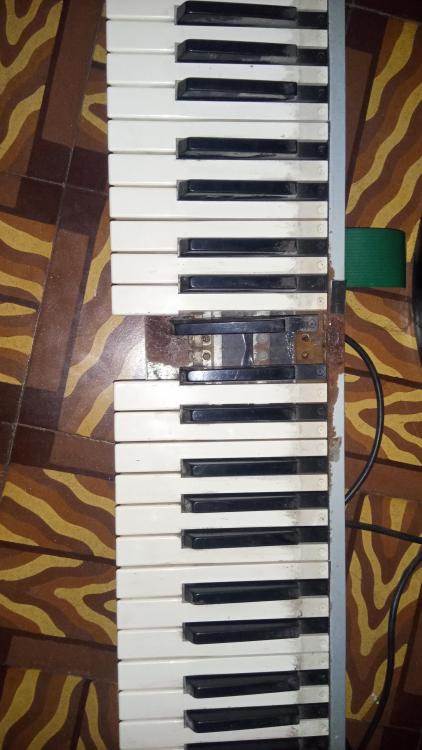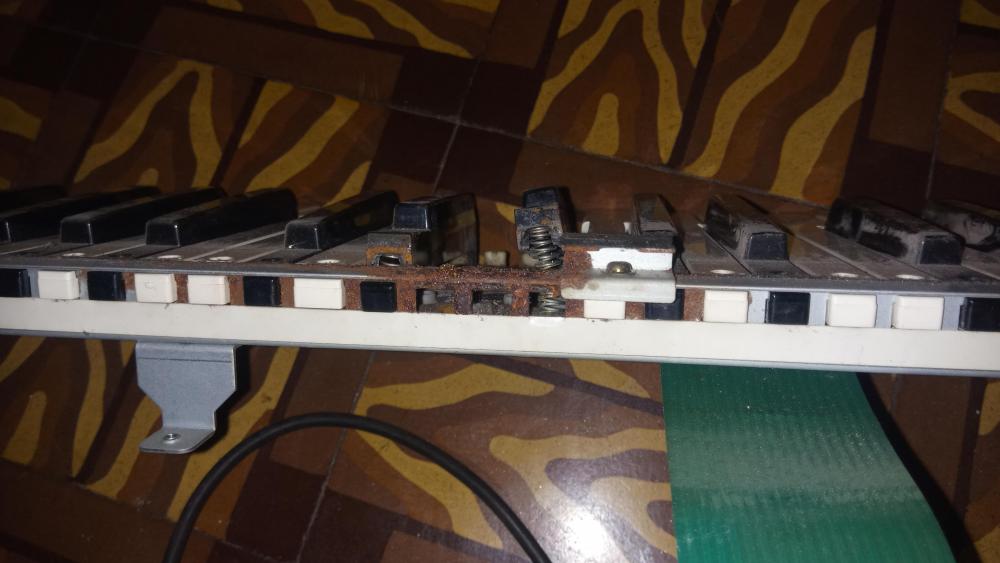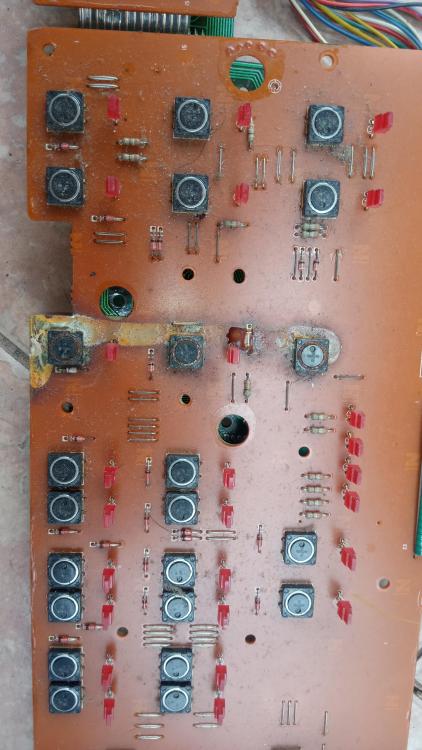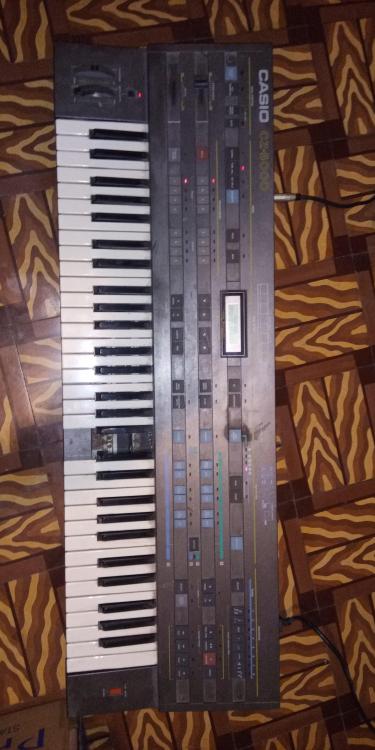
central616
Members-
Posts
29 -
Joined
-
Last visited
Content Type
Profiles
Forums
Downloads
Everything posted by central616
-
My humble review of the PX-5S after six months of use.
central616 replied to central616's topic in Privia Pro PX-5S
The concept of Hex layer ir rather simple. It's not as intrincated as an 8 operator FM or Kurzweil V.A.S.T.. But simple doesn't imply lack of power. The PX-5S is a beast on its own. Yeah, it makes things easier. Is not continuous though. A huge part of the understanding of the instrument is to know how to deal with it's limitations. There's no way to satisfy everyone. I would give away the whole guitar and bass section in exchange of a good CP sound. But probably I'm in the minority. Nevertheless, the capabilities of this piano greatly surpass it's drawbacks, which at this price point is a little unfair to say it has "drawbacks". P.S.: Any suggestions on how to solve the "issue" of the noise gate on the audio inputs? -
My humble review of the PX-5S after six months of use.
central616 posted a topic in Privia Pro PX-5S
Hi everyone. I own a XW-P1 for 4 years now, and since early 2018 I was Looking for a 88 key digital piano, because acoustic and electric piano sounds are maybe the weakest point of the XW. I was close to purchase a Kawai ES8 and later an Artis 88, but due to high inflation rates in my country, prices jumped 50% from one day to another. After this episodes, my frustration growed and my bank account shrinked. So during 2019 I abandoned the idea of a DP and I started looking for used upright. None were of my liking. The only one that sounds very good has a terrible paint job. But then, magic occurred. In ealy march I found a new PX-5S for the equivalent of 680 dollars. In my country this is cheaper than a PX-160, a Yamaha P-45 and half the price of a PX560. Without any dubt I brought it and a week later, I was unboxing it. First look: It's damn beautiful. I really love the design, and that pearled white colour is stunning. I don't understand at all the critics. I mean, why you would want another boring all matte black instrument?. The piano is also very well packaged and protected. Build quality: being all plastic, it's not on the same league as other keyboards, but that said, the materials used seems to be excellent, and that's great for transporting because of the lower weight. The power supply is small but also well constructed. The pedal is very light and springy, I don't like at all. The panel buttons are nice. The four knobs do the job but they look and feel cheap. The sliders have a very short travel. That's good on some situations when you are using them with you left hand while also playing a note, but you loose a lot of fine control. Interface: In an era of deep menus for editing, the PX-5S is rather accesible. The synth engine is rather simple (but very powerful) so programming a custom sound is not a nighmare. However, the screen es TINY. Why they put such a small and devoid of information screen?. Nonsense really. And things are worse considering the lack of continuous wheel for navigation and the arrow buttons being in a line instead of a cross pattern. The pc editor is nice., but I really hate to use the computer for creating music. Well, I have no choice. I'm getting used to it. Sounds: A thing that Casio does since ancient times is selling excellent instruments with underwhelming presets. At first, the PX-5S sounds rather sterile, but once you start tweaking a little, this instrument comes to life. The pianos are of great quality and detail. EP's are very good. Factory strings and synths are lackluster, but the potential is so big that you could create extremely beautiful ones. On the other hand organs are third rate, which I don't care since this instrument is not meant to be an organ clone. Same with guitars, violins, brass instruments and acoustic drums. They are old and low quality samples. Still you can get some usable ones due to the powerful DSP this piano has. Speaking of pianos, they have damper noise, string resonance and damper resonance (I think that's the name). I've found them rather annoying and fake sounding, specially the damper noise, so I disable it. The strings and damper resonance work well at a low level. There are a bunch of sounds not represented such as Mellotron, 12 string guitar, and Electric Grand. Controls: With 6 sliders, 4 knobs, and 2 foot pedals all assignable you can control most parameters you need in a live situation. I still miss a foot volume control (happily Casio included this in newer models) and the half pedaling support. I had a Yamaha P120 from 2002 and it already supported that feature. I suppose that keyboard's technology doesn't improve at the same rate as computers or cell phones... Extras: It has USB audio recorder, which is very helpful for doing demos. This really is a feature that most keyboards should have but is not the case. It can record external audio but I never used that because the audio inputs have a noise gate (the XW-P1 too) which cut the sound when it is at a not so low volume. A shame really. In conclusion: is not a all in one workstation, but it doesn't pretend to be that. It's a wonderful piano and a powerful syntesizer. Just that. If that is what you're looking for, this instrument is perfect. I'm very happy with this purchase which happily I did right before the quarantine! PROS Design Price Editing capabilities Use as a controller Weight CONS Small screen No half pedaling and Foot volume support No mono synth mode The biggest disappointment for me was the lack of a CP70 sound. Why Casio?... Why? Thanks for reading, and I really want to know your experience with the PX-5S. -
Yes, play with the PX-5S.
-
decay for notes played on grand piano
central616 replied to Roly's topic in WK-7500/7600 - CTK-7000/7200
Sadly is not possible. The piano samples in those keyboards are very short, and this cannot be edited. The best thing you can do is connect your WK to a PC and use a piano software. -
It makes it pointless to use headphones (Privia).
central616 replied to sslyutov's topic in PX-360 and CGP-700
There are some trolls and/or Casio haters in this thread... -
You are right. Sadly it sounds pretty bad. I was hoping much more from the MZ because I used both a CTK 731 and a CTK 900 and they were fantastic. Maybe the headphone jack isn't suited for recording?
-
What is your ideal Next Generation of PX-5S for 2020?
central616 replied to Reg MidiStage's topic in Privia Pro PX-5S
Of course. Humans are diverse and so are their tastes. A lot of people praise the Kawai ES110 sounds and action and when I tested it I was shocked because how bad the sounds and the feel of the keys were to me. I like Casio brand because they offer products at a price no one other does, at least in my country. But reality is: Casio never really entered the pro market. Mostly because they never had a product in this category (except the CZ synths and maybe th PX-5S itself). Casio never released a "Forte", a "Motif" or a "Kronos". Probably they won't and this discussion is in vain. But if they have plans to do it, they should improve the quality in almost every aspect to justify the price. -
What is your ideal Next Generation of PX-5S for 2020?
central616 replied to Reg MidiStage's topic in Privia Pro PX-5S
I tested it and I don't like it very much. It's lighter than the old Privias action and as I mentioned in other post the weight difference between the black and white keys is real. Not a deal breaker for me, but if Casio want to make a board for pros they should take note of it. -
Discussing the Casio PXS3000 and Review | NAMM 2020
central616 replied to kybdsammer's topic in Privia PX-S Series
I don't think that the weight difference on the keys is a real issue. I mean, an accomplished classical pianist would not buy this keyboard, and probably he or she wouldn't even buy a digital piano. I tested the PX-S3000 and the difference in weight is noticeable. It was probably a mistake from Casio to compromise the action in favor of the visual look, but is still a great board for the public it's aimed. -
What is your ideal Next Generation of PX-5S for 2020?
central616 replied to Reg MidiStage's topic in Privia Pro PX-5S
My ideal next model of CASIO PX-5S: 1. Expression pedal: it was a huge mistake to not have it included originally. 2. Improved sounds: new string sets, better pianos and EP's (Rhodes specially), and please include a CP70 sound. A dedicated organ sim would be nice, but could be left out to keep the price low. 3. New action: add some felt and better grease to make the action last longer and less noisy. Don't put the action featured on the new PX-S series. 4. USB audio interface: if the PX-5S can record audio on a USB stick, the new model should be capable of this. 5. Music rest: after all, this is a piano. 6. Mono synth mode -
It's recorded with an external microphone. The only things connected to the keyboard are the sustain pedal and the power cord.
-
That's true. Also it works just fine and still sounds amazing.
-
I saw all of his videos but sadly his demos aren't good. His playing style is very busy and he never records the audio through the line outputs, which results in a very poor quality and distorted sound. Great player though, and in his defense he is the only person who did such a deep demonstration of the MZ.
-
Quote: "It looks like a Matsushita keybed, and your K103U keys listed under the Casio CT series seem to match up extremely well." A man nearby is selling a non working CT-670. Maybe I'm a little lucky and the whole action is the same. I have to completely disassemble the action in order to restore it because is full of rust. Some pics
-
Zooming in the pic it can be seen that the effects are Reverb and "Reverb/Chorus".
-
I saw this video before I brought the XW-P1 and was one of the reasons why I did that. Obviously you have to have the vent and be Ed Alstrom to sound like this, but it shows the capabilities of the board. I would be nice if you share some audio samples of the MZ2000. Thanks
-
Brad, could you review this board? I'm very curious and there is very little information and pro recordings of it on the net. I would love to listen to the organ sim running through a vent.
-
Hello everyone. I disassembled a CZ5000 which is in pretty bad condition. I have to solder new tact switches and change some diodes, caps and resistances because some strange liquid was dropped on it. The case is that this liquid also corroded the keybed and 4 keys are broken. I asked to the Casio Official service of my county and they want around 50 dollars for the replacement keys, which is a lot for me. So, my concrete answer: Is there another Casio keyboard from that era with the same action? The CT line are pretty cheap and I could use the internals to another project I'm working (bass pedals).
-
I second this. I recently purchased the PX-5s and I was going to sell the XW, but when I put both aside, I fell in love with the XW again. I didn't have the opportunity to play the MZ-X500, but judging by it's specs it seems to be a superior machine than the XW. So why don't you choose it?
-
The piano has a very long decay time compared with previous models (CTK, WK and XW). But you are correct with the screen visibility issue.
-
I think this is a fair observation. With the PX5s CASIO moved sucesfully to the pro market, but with the MZ-X I think they did the wrong movement. It's a good board, you can do almost everything yo want with it, but it doesn't outshine any keyboard in the market in the same price range
-
So, replacing the propietary jack with two 1/4 jack would be correct?
-
Hi guys. I was listenig to the MZ-X500 demos, and I think that it's an amazing board, though far from clear my doubts they have done nothing but deepen them. I have some questions: Toneweel organ: It's the same as on XW-P1? Syntesizer: Does it have a monophonic synth like the XW-P1? Hex layer: Same engine as PX-5S and PX-560? PCM Sounds: They are the same on PX-560? I heard beatiful strings on the MZ-X500, with a lot of artuculations. I don't know if the PX-560 can do that. Thanks and keep CASIO growing!
- 8 replies
-
- casio mz-x500
- casio px-560
-
(and 2 more)
Tagged with:
-
Thansk for answer. I tried changing cables, mixer inputs and when i connected another keyboard (Casio WK1800), it sounds fine. I used mostly thr Tone mode, so the XW-P1 is guilty. This was the reason i posted this on this forum. Any suggestions?
-
Yesterday I took, for the first time, my casio to a reharsal with my band and sadly discovered that the output volume is extremely low. I had to put all the equipment at maximum power because really it sounds very low, especially the PCM sounds. My question is: It's a manufacturing defect, or my unit? How I could fix it? Thanks for your help!





